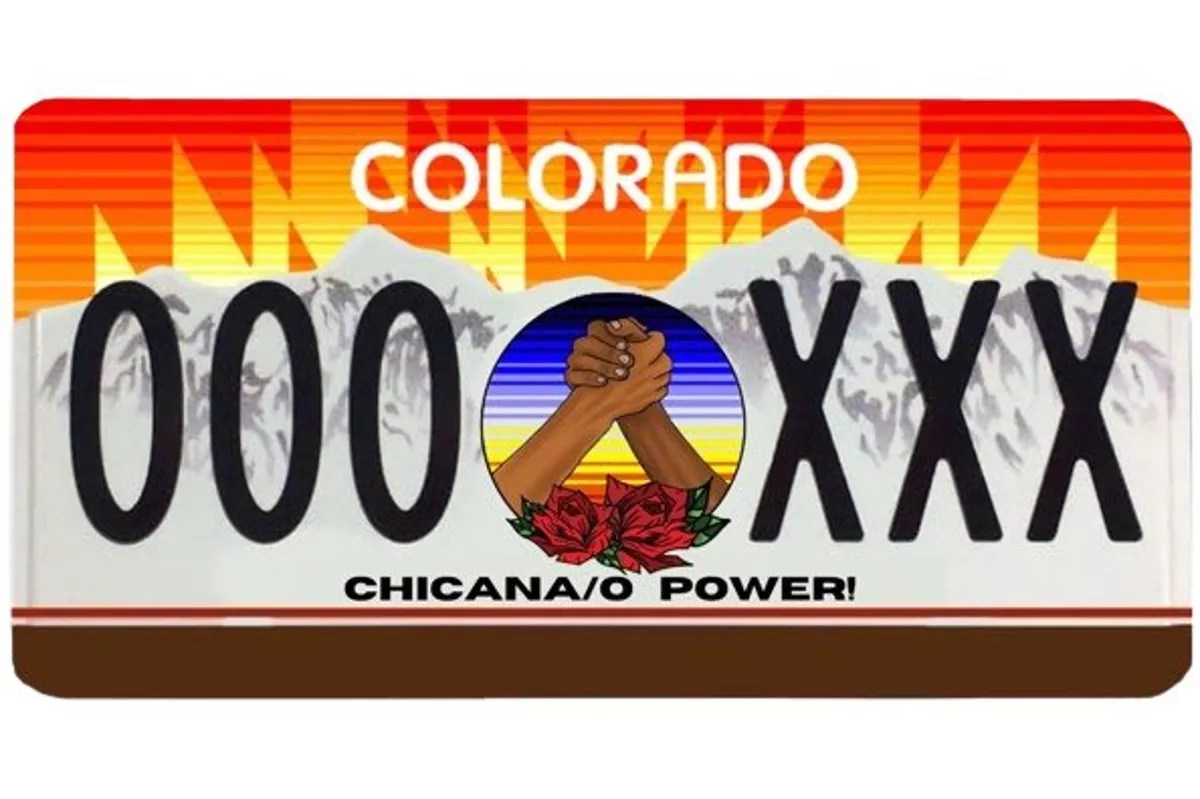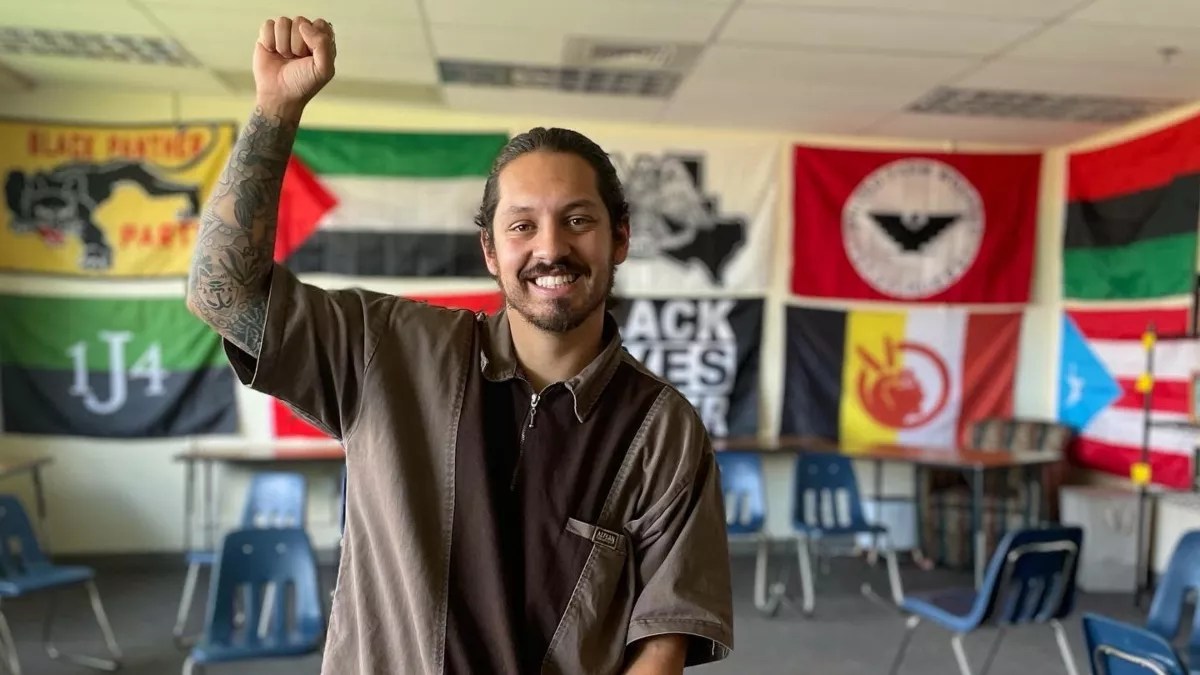
Courtesy Tim Hernández

Audio By Carbonatix
A simple black, blue, red or green license plate may not say as much about you as you want. Maybe your idea for a vanity plate was too foul, lewd or rude to be accepted.
State Representative Tim Hernández wants to offer Coloradans another license plate option, one that would support youth leadership programs around the state and boast a design honoring Chicano culture.
“The standard license plates are nice, but they’re not community-driven,” Hernández says. “Our license plates are built around our community. It was workshopped by our community, it was designed by artists in our community. Ours is very rooted in community, and the purpose is to fund and expand wonderful programs in the state.”
Colorado already offers more than 200 specialty plate designs representing sports teams, charities, causes, national parks, military branches, time periods and the Pueblo chile. But the only specialty plates currently honoring culture or heritage are the Italian American Heritage and American Indian Scholar plates.
Working with state Senator Julie Gonzales, Hernández introduced a bill, HB24-1105, that would charge a pair of $25 fees for a colorful orange-and-brown Chicano license plate. Those fees would go to the Highway Users Tax Fund and a kitty reserved for Chicano youth leadership and education programs selected by El Movimiento Sigue, a Pueblo-based nonprofit.
“A license plate is a good mechanism to get some state funding directly toward some outcomes we would like to see in the community,” Hernández says. “Not only provide representation that’s really important for Chicanos in Colorado, but also an opportunity for us to collectively fund youth leadership programs.”
The Chicano youth programs he has in mind include the Aquetza Academic Summer Program in Boulder, the Rita J Martinez Youth Leadership Conference in Pueblo, and the La Raza Youth Leadership Conference in Denver. Before he was elected by a committee to fill a legislative vacancy last fall, Hernández was a high school Chicano Studies teacher in Aurora, and “I’ve taught at most of the Chicano youth leadership programs across the state,” he says.
“When I was fourteen years old, I went to the La Raza Youth Leadership Conference at Metro State University,” he recalls. “I walked out of that deciding that I want to be a revolutionary history teacher, and it became a huge motivating factor for the reason I thought of myself as a college student, why I pursued teaching, why I wanted to learn a lot about Chicano studies.”
Colorado was a hotbed of Chicano activism in the 1960s and 1970s. The Chicano activist group Crusade for Justice and its leader, Rodolfo “Corky” Gonzales, were based in Denver, where key events like the West High School blowouts took place.
In addition to Chicano youth leadership, sales of the plates can can also fund “ethnic studies programs, Chicano studies programs, access to higher education for Chicano students, youth violence prevention programs for Chicano students,” Hernández says.

Tim Hernández went from a Chicano studies teacher to a state legislator.
Courtesy of Tim Hernández
“The license plate is a great way for our community to step up and expand and fund those programs,” he adds. “But more important, to carry a little bit of pride as we drive our cars and our lowriders and our motorcycles around the city, too.”
Collecting 3,000 petition signatures in 48 hours to support his idea for a specialty plate, Hernández documented the demand, and says that he expects as many as 10,000 could be sold in the first year. Colorado has about 1.3 million Latino residents.
“I think that 10,000 isn’t too hard of a number to shoot for. I realistically would like to get 10,000 Chicano license plates on the streets within the next year,” Hernández says. “Once people see the plate, they’re probably going to want it.”
Former state representative Joe Salazar tried to pass a similar bill in 2016, but it died in a Republican-led Senate Finance Committee. Hernández says he sees “a really good path for the bill” this time because of the “trifecta” of a Democrat-controlled House, Senate and governor’s office. Coloradans could start seeing the plate on the roads as early as the summer, he predicts, but “we’ve got a lot of steps until then.”
Earlier this month, Hernández and Gonzales considered designs submitted by twenty artists from all over Colorado, ranging in age from 14 to 85 years old. The two legislators settled on the “serape design” by 23-year-old Larysa Medina of Alamosa.
The winning design has brown and red stripes across the bottom, reminiscent of a serape. The top depicts a red, orange and yellow sunset in a geometric style that looks woven onto the serape. Although the serape is closely linked to Mexican culture, Hernández thinks it reflects the diversity within the Chicano identity.
“We landed on the serape design because we felt like it was a good intersection for a lot of different folks,” Hernández says. “One for Mexican-American folks, two for folks from other communities from outside of Mexico. There are Chicanos who are Venezuelan. There are Chicanos that are from Brazil. There are Chicanos from Cuba. There’s all kinds of different folks that fit within our diaspora.”